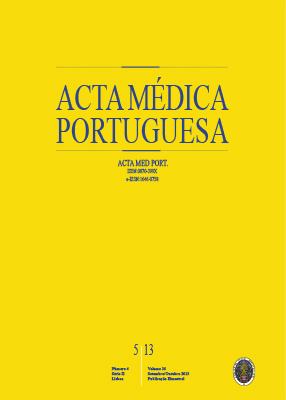TORCH Serology and Group B Streptococcus Screening Analysis in the Population of a Maternity
DOI:
https://doi.org/10.20344/amp.564Abstract
Introduction: Systematic screening for TORCH infections and group B Streptococcus (GBS) during pregnancy has been an important factor in the improvement of perinatal care.Aim: To evaluate TORCH serology and GBS carriers state in the population of a maternity, to assess variability with age and nationality and to search for congenital infections.
Material and Methods: Non-probabilistic prevalence study.
Results: 9508 TORCH and 2639 GBS results were registered. Immunity rate for rubella was 93.3%, higher for Portuguese women; for toxoplasmosis it was 25.7%, higher among the oldest and foreign women; IgG for CMV was positive in 62.4%, no influence of age was found. VDRL was reactive in 0.5%; HBsAg was found to be positive in 2.3%, higher in foreign women. Antibodies for hepatitis C virus and HIV were found respectively in 1.4% and 0.7%. No congenital infections were diagnosed. GBS carrier state was found in 13.9%.
Discussion: A high rate of positive IgG was found for rubella reflecting vaccines policy. For toxoplasmosis the low rate of positives means that a high number of pregnant women have to repeat serology during pregnancy with inherent costs. Like in the general population, a high rate of CMV positive mothers was found. For some infections we found that foreign women had different conditions.
Conclusion: Knowledge on TORCH and GBS state helps to better draw guidelines concerning screening policies during pregnancy.
Downloads
Downloads
Published
How to Cite
Issue
Section
License
All the articles published in the AMP are open access and comply with the requirements of funding agencies or academic institutions. The AMP is governed by the terms of the Creative Commons ‘Attribution – Non-Commercial Use - (CC-BY-NC)’ license, regarding the use by third parties.
It is the author’s responsibility to obtain approval for the reproduction of figures, tables, etc. from other publications.
Upon acceptance of an article for publication, the authors will be asked to complete the ICMJE “Copyright Liability and Copyright Sharing Statement “(http://www.actamedicaportuguesa.com/info/AMP-NormasPublicacao.pdf) and the “Declaration of Potential Conflicts of Interest” (http:// www.icmje.org/conflicts-of-interest). An e-mail will be sent to the corresponding author to acknowledge receipt of the manuscript.
After publication, the authors are authorised to make their articles available in repositories of their institutions of origin, as long as they always mention where they were published and according to the Creative Commons license.









